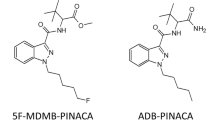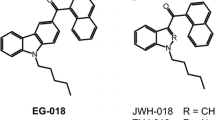Abstract
Background
PB-22 (1-pentyl-8-quinolinyl ester-1H-indole-3-carboxylic acid) and 5F-PB-22 (1-(5-fluoropentyl)-8-quinolinyl ester-1H-indole-3-carboxylic acid) are new synthetic cannabinoids with a quinoline substructure and the first marketed substances with an ester bond linkage. No human metabolism data are currently available, making it difficult to document PB-22 and 5F-PB-22 intake from urine analysis, and complicating assessment of the drugs’ pharmacodynamic and toxicological properties.
Methods
We incubated 10 μmol/l PB-22 and 5F-PB-22 with pooled cryopreserved human hepatocytes up to 3 h and analyzed samples on a TripleTOF 5600+ high-resolution mass spectrometer. Data were acquired via TOF scan, followed by information-dependent acquisition triggered product ion scans with mass defect filtering (MDF). The accurate mass full scan MS and MS/MS metabolite datasets were analyzed with multiple data processing techniques, including MDF, neutral loss and product ion filtering.
Results
The predominant metabolic pathway for PB-22 and 5F-PB-22 was ester hydrolysis yielding a wide variety of (5-fluoro)pentylindole-3-carboxylic acid metabolites. Twenty metabolites for PB-22 and 22 metabolites for 5F-PB-22 were identified, with the majority generated by oxidation with or without glucuronidation. For 5F-PB-22, oxidative defluorination occurred forming PB-22 metabolites. Both compounds underwent epoxide formation followed by internal hydrolysis and also produced a cysteine conjugate.
Conclusion
Human hepatic metabolic profiles were generated for PB-22 and 5F-PB-22. Pentylindole-3-carboxylic acid, hydroxypentyl-PB-22 and PB-22 pentanoic acid for PB-22, and 5′-fluoropentylindole-3-carboxylic acid, PB-22 pentanoic acid and the hydroxy-5F-PB-22 metabolite with oxidation at the quinoline system for 5F-PB-22 are likely the best targets to incorporate into analytical methods for urine to document PB-22 and 5F-PB-22 intake.

Metabolism of synthetic cannabinoids PB-22 and 5F-PB-22 by human hepatocyte incubation and high-resolution mass spectrometry









Similar content being viewed by others
References
Sedefov R, Gallegos A, Kind L, Lopez D, Auwarter V, Hughes B. EMCCDA 2009 Thematic paper - Understanding the ‘Spice’ phenomenon. Office for Official Publications of the European Communities, 2009
Hermanns-Clausen M, Kneisel S, Szabo B, Auwarter V (2012) Acute toxicity due to the confirmed consumption of synthetic cannabinoids: Clinical and laboratory findings. Addiction 108:534–44
Seely KA, Lapoint J, Moran JH, Fattore L (2012) Spice drugs are more than harmless herbal blends: A review of the pharmacology and toxicology of synthetic cannabinoids. Prog Neuropsychopharmacol Biol Psychiatry 39:234–43
Forrester MB, Kleinschmidt K, Schwarz E, Young A (2012) Synthetic cannabinoid and marijuana exposures reported to poison centers. Hum Exp Toxicol 31:1006–11
Perrone D, Helgesen RD, Fischer RG (2013) United States drug prohibition and legal highs: How drug testing may lead cannabis users to spice. Drugs: Education Prevention Policy 20:216–24
European Monitoring Centre for Drugs and Drug Abuse. European Database on New Drugs. https://ednd-cma.emcdda.europa.eu/ (Accessed Sept. 2013).
NMS Labs. Designer drug trends report. NMS Labs, 2013
US Government. Synthetic Drug Abuse Prevention Act of 2012 (S.3187), 2012
Uchiyama N, Kawamura M, Kikura-Hanajiri R, Goda Y (2012) Identification of two new-type synthetic cannabinoids, N-(1-adamantyl)-1-pentyl-1H-indole-3-carboxamide (APICA) and N-(1-adamantyl)-1-pentyl-1H-indazole-3-carboxamide (APINACA), and detection of five synthetic cannabinoids, AM-1220, AM-2233, AM-1241, CB-13 (CRA-13), and AM-1248, as designer drugs in illegal products. Forensic Toxicol 30:114–25
Uchiyama N, Kawamura M, Kikura-Hanajiri R, Goda Y (2013) URB-754: A new class of designer drug and 12 synthetic cannabinoids detected in illegal products. Forensic Sci Int 227:21–32
Uchiyama N, Matsuda S, Kawamura M, Kikura-Hanajiri R, Goda Y (2013) Two new-type cannabimimetic quinolinyl carboxylates, QUPIC and QUCHIC, two new cannabimimetic carboxamide derivatives, ADB-FUBINACA and ADBICA, and five synthetic cannabinoids detected with a thiophene derivative α-PVT and an opioid receptor agonist AH-7921 identified in illegal products. Forensic Toxicol 31:223–40
Department of Justice, Drug Enforcement Administration. Schedules of controlled substances: Temporary placement of three synthetic cannabinoids into schedule I. Federal Register, Vol. 78, 2013.
Uchiyama N, Matsuda S, Kawamura M, Kikura-Hanajiri R, Goda Y Identification of two new-type designer drugs, piperazine derivative MT-45 (I-C6) and synthetic peptide noopept (GVS-111), with synthetic cannabinoid A-834735, cathinone derivative 4-methoxy-α-PVP, and phenethylamine derivative 4-methylbuphedrine from illegal products. Forensic Toxicol. doi:10.1007/s11419-013-0194-5
Martin T. Report about the number of exhibits containing synthetic cannabinoids from October 2011 till May 2013 analyzed by the Drug Chemistry Branch, USACIL. Personal communication, Castaneto M, 2013.
Berrier A (2013) Classes and structures of emerging cannabimimetics and cathinones. Emerging Trends in Synthetic Drugs, Workshop, Gaithersburg, MD, USA
Lavis LD (2008) Ester bonds in prodrugs. ACS Chem Biol 3:203–6
Reddit Drug User Forum. My PB-22 experience. http://www.reddit.com/r/Drugs/comments/1b4mb8/my_pb22_experience/ (Accessed August 27, 2013).
DrugsForum. 5 F-PB-22 drug info. http://www.drugs-forum.com/forum/showthread.php?t=202998 (Accessed August 27, 2013).
Gomez-Lechon MJ, Castell JV, Donato MT (2008) An update on metabolism studies using human hepatocytes in primary culture. Expert Opin Drug Metab Toxicol 4:837–54
Wohlfarth A, Pang S, Zhu M, Gandhi AS, Scheidweiler KB (2013) Liu H.-F., Huestis MA. First metabolic profile of XLR-11, a novel synthetic cannabinoid, obtained by using human hepatocytes and high-resolution mass spectrometry. Clin Chem 59:1638–48
Grigoryev A, Savchuk S, Melnik A, Moskaleva N, Dzhurko J, Ershov M et al (2011) Chromatography-mass spectrometry studies on the metabolism of synthetic cannabinoids JWH-018 and JWH-073, psychoactive components of smoking mixtures. J Chromatogr B Analyt Technol Biomed Life Sci 879:1126–36
Sobolevsky T, Prasolov I, Rodchenkov G (2012) Detection of urinary metabolites of AM-2201 and UR-144, two novel synthetic cannabinoids. Drug Test Anal 4:745–53
Hutter M, Broecker S, Kneisel S, Auwarter V (2012) Identification of the major urinary metabolites in man of seven synthetic cannabinoids of the aminoalkylindole type present as adulterants in ‘herbal mixtures’ using LC-MS/MS techniques. J Mass Spectrom 47:54–65
Gandhi A, Zhu M, Pang S, Wohlfarth A, Scheidweiler K, Liu H-f, Huestis M. First characterization of AKB-48 metabolism, a novel synthetic cannabinoid, using human hepatocytes and high-resolution mass spectrometry. AAPS J 2013:1-8.
Horng H, Benet LZ. The non-enzymatic reactivity of the acyl-linked metabolites of mefenamic acid towards amino and thiol functional group biomolecules. Drug Metabolism and Disposition 2013
Andersen. Cosmetic ingredient review: Final amended report on the safety assessment of oxyquinoline and oxyquinoline sulfate as used in cosmetics. Int J Toxicol 2006;25:1-9.
Gershon H, Parmegiani R (1963) Antimicrobial activity of 8-quinolinol, its salts with salicylic acid and 3-hydroxy-2-naphthoic acid, and the respective copper (II) chelates in liquid culture. Appl Microbiol 11:62–5
Youatt J (1982) Oxine, ferric oxine and copper oxine as inhibitors of growth and differentiation of allomyces macrogynus. Aust J Biol Sci 35:565–72
National Toxicology Program. NTP technical report on the toxicology and carcinogenesis studies of 8-hydroxyquinoline in F344/N rats and B6C3F1 mice (feed studies). NTP TR 276, NIH Publication No 85-2532, 1974
National Library of Medicine Database. Indium-11-oxyquinoline solution. National Library of Medicine, 2013
Chimalakonda KC, Moran CL, Kennedy PD, Endres GW, Uzieblo A, Dobrowolski PJ et al (2011) Solid-phase extraction and quantitative measurement of omega and omega-1 metabolites of JWH-018 and JWH-073 in human urine. Anal Chem 83:6381–8
Zhang Q, Ma P, Cole R, Wang G (2006) Identification of in vitro metabolites of JWH-015, an aminoalkylindole agonist for the peripheral cannabinoid receptor (CB2) by HPLC-MS/MS. Anal Bioanal Chem 386:1345–55
Sobolevsky T, Prasolov I, Rodchenkov G (2010) Detection of JWH-018 metabolites in smoking mixture post-administration urine. Forensic Sci Int 200:141–7
Grillo MP, Knutson CG, Sanders PE, Waldon DJ, Hua F, Ware JA (2003) Studies on the chemical reactivity of diclofenac acyl glucuronide with glutathione: Identification of diclofena-s-acyl-glutathione in rat bile. Drug Metab Dispos 31:1327–36
Shore LJ, Fenselau C, King AR, Dickinson RG (1995) Characterization and formation of the glutathione conjugate of clofibric acid. Drug Metab Dispos 23:119–23
Cayman Chemical. www.caymanchem.com (Accessed November 2013).
Acknowledgments
This research was funded by the Intramural Research Program of the National Institute on Drug Abuse, National Institutes of Health and AB SCIEX.
Author information
Authors and Affiliations
Corresponding author
Electronic supplementary material
Below is the link to the electronic supplementary material.
ESM 1
(PDF 110 kb)
Rights and permissions
About this article
Cite this article
Wohlfarth, A., Gandhi, A.S., Pang, S. et al. Metabolism of synthetic cannabinoids PB-22 and its 5-fluoro analog, 5F-PB-22, by human hepatocyte incubation and high-resolution mass spectrometry. Anal Bioanal Chem 406, 1763–1780 (2014). https://doi.org/10.1007/s00216-014-7668-0
Received:
Revised:
Accepted:
Published:
Issue Date:
DOI: https://doi.org/10.1007/s00216-014-7668-0




